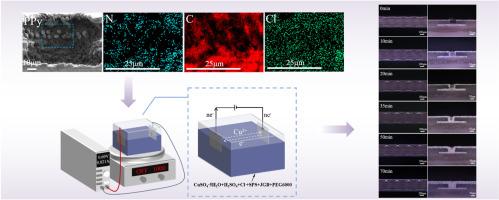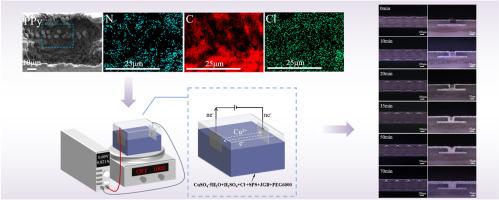原位聚合聚吡咯导电膜作为导电种子层用于印刷电路板的孔金属化及盲孔电镀填充行为
IF 4.5
2区 化学
Q2 POLYMER SCIENCE
引用次数: 0
摘要
目前,印刷电路板(pcb)的孔金属化是通过使用传统的化学铜作为导电种子,并辅以电镀铜填充工艺来实现的。由于化学镀液中含有致癌物甲醛和顽固的螯合剂,这种方法存在严重的环境问题。为了解决这一问题,提出了一种绿色聚合物聚吡咯导电膜来取代传统的化学铜作为PCB金属化的导电种子层。聚吡咯薄膜是通过在盲孔壁上原位聚合吡咯单体形成的。透射电镜和能谱分析证实,聚吡咯薄膜在盲孔壁上均匀形成。聚吡咯导电层的片电阻较低,为1.45 kΩ/sq。电化学表征表明铜在导电聚合物层上快速电沉积。接触角测量还表明,聚吡咯导电膜增强了衬底的润湿性,促进了电解质渗入过孔。充填试验表明,在70分钟左右的时间内,可实现盲孔内铜的致密超充填。热冲击实验证实了镀铜的良好附着力。这些结果表明,聚吡咯导电膜是一种非常有前途的材料,可以取代传统的化学铜作为PCB金属化的导电种子层。本文章由计算机程序翻译,如有差异,请以英文原文为准。


Polypyrrole conductive film formed by in-situ polymerization as a conductive seed layer for hole metallization of printed circuit boards and blind hole electroplating filling behavior
At present, the hole metallization of printed Circuit Boards (PCBs) is achieved through using traditional electroless copper as a conductive seed, accompanied by an electroplating copper filling process. This method has serious environmental issues due to the carcinogenic formaldehyde and recalcitrant chelating agents in the electroless plating solution. To address this issue, a green polymer polypyrrole conductive film is proposed to replace traditional electroless copper as a conductive seed layer for the metallization of PCB. The polypyrrole film is formed via in-situ polymerization of pyrrole monomers on blind-hole walls. The cross-sectional SEM and EDS analysis confirmed that the polypyrrole film was uniformly formed on the walls of blind holes. The polypyrrole conductive layer exhibits a low sheet resistance of 1.45 kΩ/sq. Electrochemical characterizations demonstrate rapid copper electrodeposition on this conductive polymer layer. The contact angle measurements also demonstrate that the polypyrrole conductive film enhances substrate wettability, facilitating electrolyte infiltration into the vias. The filling experiment shows that dense super filling of copper in blind holes can be achieved within about 70 min. Thermal shock experiments confirm excellent adhesion of the plated copper. These results demonstrate that the polypyrrole conductive film represents a highly promising material to replace traditional electroless copper as the conductive seed layer for the metallization of PCB.
求助全文
通过发布文献求助,成功后即可免费获取论文全文。
去求助
来源期刊

Polymer
化学-高分子科学
CiteScore
7.90
自引率
8.70%
发文量
959
审稿时长
32 days
期刊介绍:
Polymer is an interdisciplinary journal dedicated to publishing innovative and significant advances in Polymer Physics, Chemistry and Technology. We welcome submissions on polymer hybrids, nanocomposites, characterisation and self-assembly. Polymer also publishes work on the technological application of polymers in energy and optoelectronics.
The main scope is covered but not limited to the following core areas:
Polymer Materials
Nanocomposites and hybrid nanomaterials
Polymer blends, films, fibres, networks and porous materials
Physical Characterization
Characterisation, modelling and simulation* of molecular and materials properties in bulk, solution, and thin films
Polymer Engineering
Advanced multiscale processing methods
Polymer Synthesis, Modification and Self-assembly
Including designer polymer architectures, mechanisms and kinetics, and supramolecular polymerization
Technological Applications
Polymers for energy generation and storage
Polymer membranes for separation technology
Polymers for opto- and microelectronics.
 求助内容:
求助内容: 应助结果提醒方式:
应助结果提醒方式:


